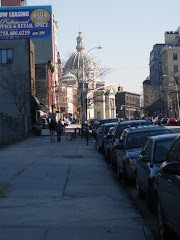Brownsville
A bit sad, too, is Zion Triangle, a dreary, cracked concrete covered sliver of park at the intersection of
It’s hard to tell whether anyone takes particular care of the memorial. I would guess not. But the general area looks clean and swept and the little shrubbery nearby looks trimmed. There are park benches along both sides so it’s no doubt kept clean for the use of the neighborhood. But it doesn’t look like the kind of place where anyone is going to leave the kind of red, white, and blue wreathes that I saw in front of the Fighting Doughboy. Then again, many monuments are decorated on Veterans Day and Memorial Day even if at no other time of the year, and this one may be.
But it’s too bad that it’s not better cared for because the names of the 92
As the name of the park indicates, most though not all the men memorialized were Jewish (though the park name came before the monument). The Neighborhoods of Brooklyn mentions that at the turn of the 20th century
The limestone memorial occupies one entire end of the park and is approached by broad shallow steps; the space in front is flanked by two walls about a foot high. The central portion of the monument shows, in bas-relief, a winged female figure brandishing a sword and shield. Inscribed on the limestone walls on either side of the central figure are the names of the men honored.
Facing out on one of the small walls is carved the Star of David; on the other side is the Great Seal of the
It looks like there might have been some kind of upright pillar or post on either corner at the front but all that remains on one side is a stub and nothing on the other side.
Park Slope
An ideal location for a war memorial is occupied by the larger than life bronze figure of a charging soldier in front of the 14th Regiment Armory on
I like the medieval castle architecture of the typical armory and it provides a perfect setting for a statue like this, but see one armory and you’ve pretty much seen them all. The Park Slope building isn’t bad as armories go, not as overwhelming as others I’ve seen around
If the inscriptions sound a bit high flown and poetic it’s because they’re from poems entitled “Marco Bozzaris” (Strike for your altars) by Fitz-Greene Halleck, a now mostly forgotten 19th century American poet who was known in his time as the American Byron; and The Lays of Ancient Rome (And how can man die better) by Thomas Babington Macaulay.
Carroll Gardens
One plaque features a sailor, another a soldier, and the other two sides feature the names of the memorialized men. It was erected in 1921 by the Memorial Committee of the 8th Assembly District.
It is an imposing monument but brought down to size by it’s setting, the wide plaza surrounding it and the old growth trees towering over it. The plaques were designed by Eugene H. Morahan.
Downtown Brooklyn
A simple granite monument stands outside
It features an eagle with spread wings carved into the surface of the stone and the names of sixty nine men inscribed on the front and rear. It was erected by the Seawanhaka Democratic Club in 1919. It’s a clean, unassuming memorial set back slightly from the street and flanked by two rows of upended artillery shells, an interesting touch.
Williamsburg
Memorial Gore (formerly Woodpoint Gore), is another splendid little sliver of land where Bushwick Avenue, Metropolitan Avenue, Maspeth Avenue, Humboldt Street, and Woodpoint Road collide and fight it out among themselves in Williamsburg. As apt as it sounds for a war memorial, this isn’t the gore of Patriotic Gore, blood and gore, or even Al Gore. Gore in this case comes from an Old English word “gara” meaning just a triangular piece of land There is also Cuyler Gore in Fort Greene, a very pleasant park despite the name.
This isn’t really my favorite among all these memorials. For one, it’s in a very inconvenient place, isolated in the middle of some very heavily trafficked streets and not easy to get to. No matter where I was standing one line of traffic always seemed to have a green light so I couldn't cross.
And when you get over to it, it’s still inaccessible. Most of the other memorials, even if fenced in, let you get close enough to them at least to read any inscriptions, This one is placed just far enough away from each side, and behind iron fences and shrubbery just high enough, to pretty much block any good view. The only way I could get any shots was to wrap the camera cord around my wrist, stick my arms through the fence, try to hold the camera straight, and hope for the best.
And I’m just not crazy about that triangular column with the globe with the smaller globe with the eagle. It reminds me of a geometry exercise or a child's toy.
Still, all of that no doubt helped to keep it in pristine condition. And it is still there, something you can’t say about Novelli's work in
More after my next foray out into this beautiful borough. Maybe I will wait until after Veterans Day to see which monuments were decorated for the occasion.
P.S. Still no crosses, Justice Scalia.
























